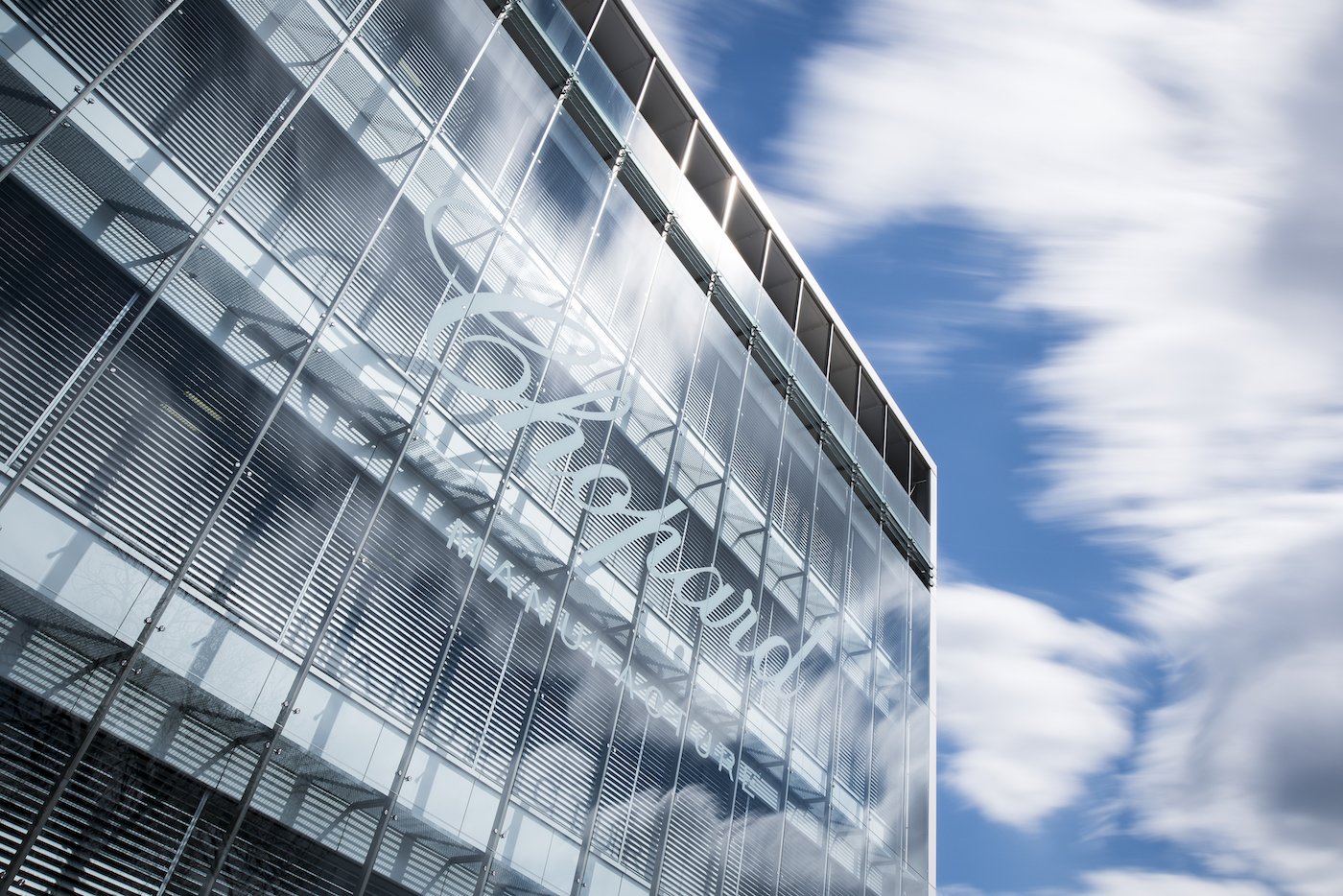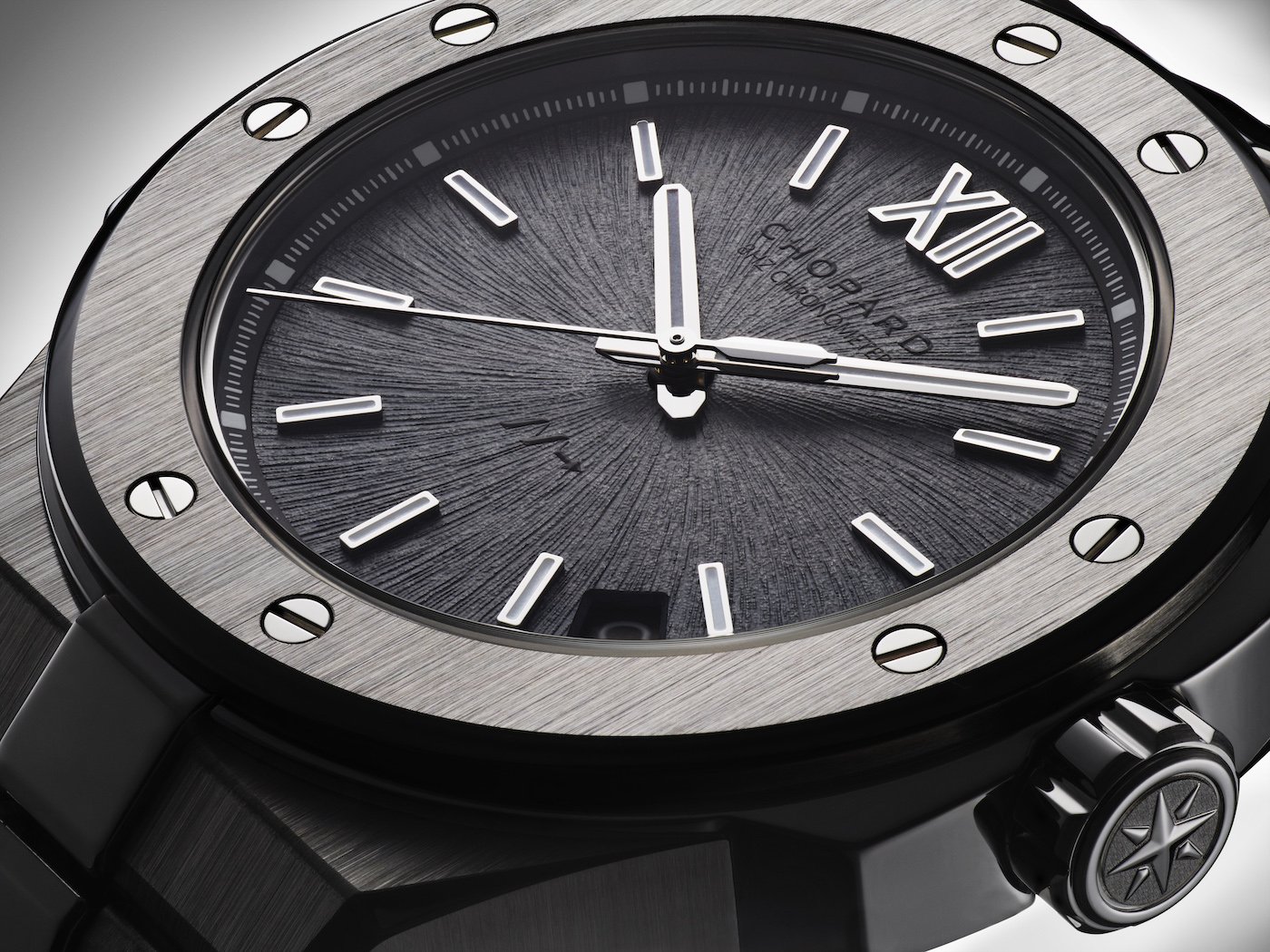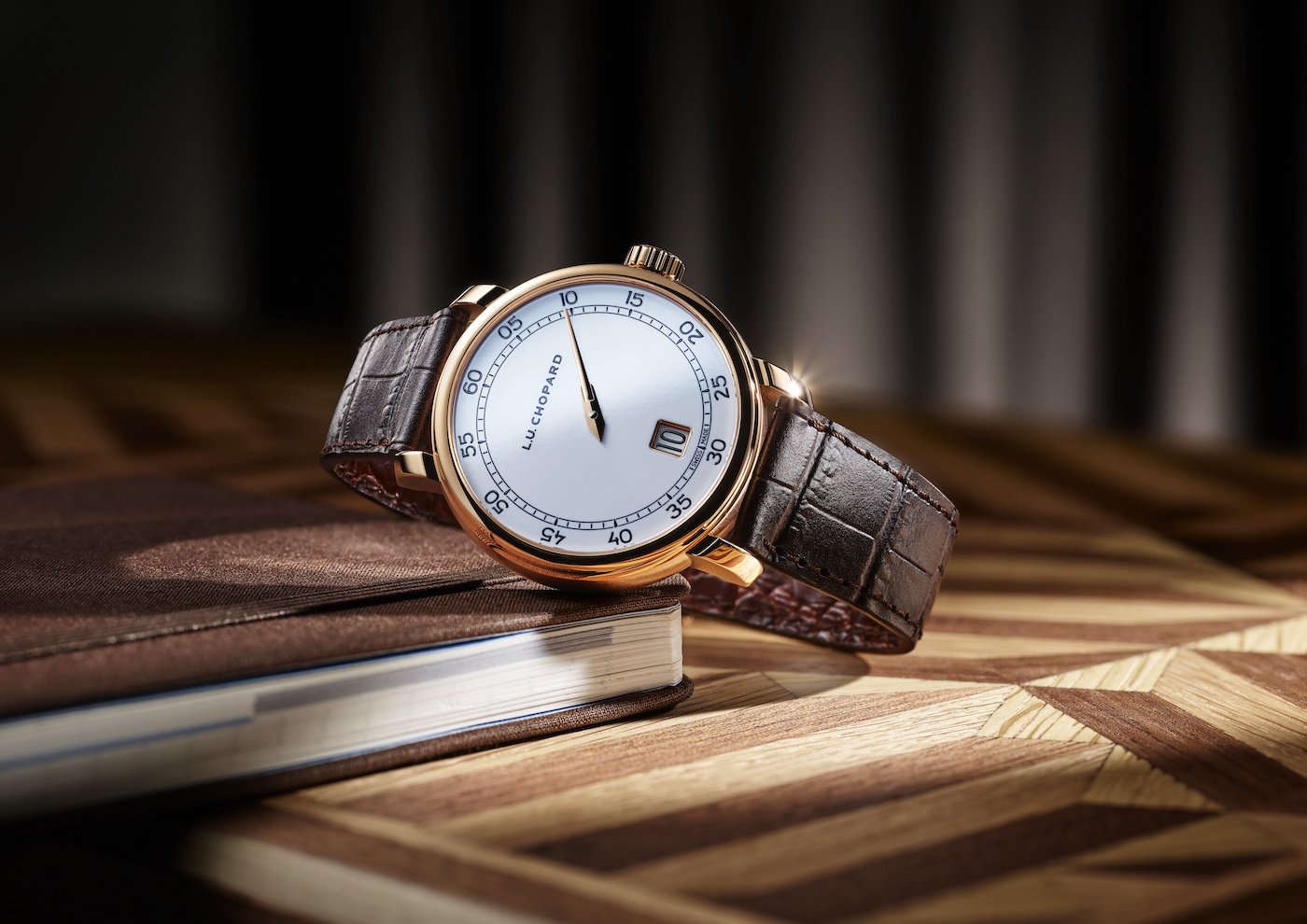he year is 1993-1994. The mechanical watch revival is in full swing and the grand manoeuvres around the big watch manufacturers are just beginning (Richemont went on to buy Jaeger-LeCoultre, IWC and A. Lange & Söhne from Mannesmann in 2000).
In the view of Karl-Friedrich Scheufele, then vice-president of Chopard, it was becoming obvious and even imperative that Chopard, which was still viewed first and foremost as a jeweller who also made watches, needed to reinforce its image as a watchmaker in the full sense of the term.
It was a vital question of long-term credibility for this family business – and also a means of increasing the proportion of the men’s watch segment of its offering, then stagnating at 20 percent by value and 35 percent by volume.
-

- Announcement of the birth of the L.U.C 1.96 movement and the L.U.C 1860 watch in Europa Star in 1997
First step: an in-house movement
To achieve this, the decision was taken to create a genuine in-house movement, and to do so completely independently and with the greatest discretion. So Karl-Friedrich Scheufele contacted Michel Parmigiani, who was established in Fleurier and at the time still an independent watchmaker. Together, they defined the type of movement to be created and divided up the tasks involved in producing it. The project proper began in 1995. Eighteen months later, a first prototype was ready for testing.
At the same time, thought was given to the means of production. “It would have been perfectly possible to do it in the workshop at Meyrin, where the movements were already reassembled and regulated and work on the ébauches, including certain complications, was carried out,” Karl-Friedrich Scheufele explains. “But I wanted to create a special, dedicated entity because it was obvious to go any further, we had to build a unit to produce ébauches.”
“I wanted to create a special, dedicated entity because it was obvious to go any further, we had to build a unit to produce ébauches.”
-

- A review of L.U.C models since 1997
It was decided to create it in Fleurier. The region has a long history of watchmaking, with a well-trained workforce and the added advantage of being off the beaten track, calm, peaceful, and not swarming with rival manufactures. In 1996, business premises were found. Chopard Manufacture was founded and the adventure could truly commence.
Chopard hired a technical designer, a prototypist and several precision mechanics and took things into its own hands. The movement was improved, optimised, its rotor resized, and in 1996 the L.U.C 1.96 was born. It would power the first watch, the L.U.C 1860 (the year when Chopard was founded), which came out in 1997.
Independence and excellence
“What is Chopard doing?” “They’ve gone mad!” “They’re getting above themselves.” The reactions of the watchmaking community came swiftly with the surprise appearance of this new player on the chessboard of mechanical haute horlogerie.
And indeed, this arresting, award-winning new movement did have many things going for it. It went on to form the basis for the future development of Chopard Manufacture. The L.U.C 1.96 was designed from the outset as a sophisticated base movement powerful enough to support future complications. Featuring a superimposed double barrel, it has an impressive 70-hour power reserve and is very thin, thereby permitting the creation of elegant watches; its superlative finishes entitle it to bear the Geneva Seal and each item is systematically COSC-certified.
25 years later, this continually optimised movement is still in production. It enabled Chopard Manufacture to take off and gradually to guarantee and consolidate Chopard’s manufacturing independence.
“What is Chopard doing?” “They’ve gone mad!” “They’re getting above themselves.” The reactions of the watchmaking community came swiftly with the surprise appearance of this new player on the chessboard of mechanical haute horlogerie.

Up to speed in successive stages
“From the start, the idea was to move towards semi-industrial, or rather artisanal-type industrial production,” Karl-Friedrich Scheufele explains.
The original goal was to produce 1,000 to 1,500 movements a year. This they attained in stages, although some milestones were reached very rapidly.
Having started with five employees, Chopard Manufacture soon grew from a workforce of ten, to 15 and then 20, to the point that it now employs a workforce of more than 200 people in Fleurier.
-

- Over the course of 25 years, Karl-Friedrich Scheufele has succeeded in setting up an integrated manufacture and creating an impressive series of high-end calibres, while also developing a comprehensive portfolio of artistic crafts.
It all began with a blank page. The movement had to be designed, drawn, prototyped, tested, honed. Then they had to get down to work, starting with the production of their own tools, because from the very beginning the important parts, such as the base plate and the bridge, were made entirely in-house. Gradually, new crafts and skills were added: design, the physical production of components, testing, certification and, remarkably, the very highest standard of decoration, which is also done in-house and is certified with the Geneva Seal.
“Patiently, year after year, we’ve added activities and strengthened our vertical integration,” says Karl-Friedrich Scheufele. “Year after year, calibre after calibre has been added. Year after year, our space requirements have increased.”
The L.U.C 1.96 was designed from the outset as a sophisticated base movement powerful enough to support future complications.
Between the issuing of the L.U.C 1860 watch in 1997 and today, there have been nearly 25 major launches, from the L.U.C Quattro in 2000, with its unique four barrels and nine-day power reserve, to the latest addition to the family, the L.U.C Quattro Spirit 25. A unique collection.
-

- 2019: the L.U.C Flying T Twin
The right balance between art and industry
“Industry or industrial processes aren’t dirty words, quite the opposite. Developing a production process for a component of the requisite high quality and accuracy, in a consistent and continuous manner, is a highly complex task,” Karl-Friedrich Scheufele is keen to underscore.
This he knows from experience. In 2000, he bought the entire building housing the manufacture and began a radical transformation of it lasting several years. New spaces had to be opened up, which would also be suitable for housing heavy machinery and meeting the fast-growing production needs. But with the experience gained from the successive L.U.C collections, another objective was to gradually build up an industrial arm capable of producing large quantities of exclusive movements to drive other Chopard collections besides L.U.C – such as the new sporty chic collection, Alpine Eagle.
-

- The Alpine Eagle
So in 2008, Karl-Friedrich Scheufele founded Fleurier Ébauches. This “industrial arm” of Chopard Manufacture makes three-hand and date movements, a small, automatic ladies’ calibre and automatic men’s calibres, some versions of which are certified chronometers. In all, it produces 30,000 movements a year. They power all the mechanical watches in the Happy Sport range and, as mentioned above, the new Alpine Eagle line.
“Fleurier Ébauches would never have come into existence without Chopard Manufacture. One draws its legitimacy from the other, but together they form a coherent whole that ensures our independence and gives us the greatest possible control over our own production and our own quality criteria,” insists Karl-Friedrich Scheufele.
-

- 2021: the L.U.C Full Strike in platinum
25 years later
What would Chopard be today without its in-house manufacturing arm?
“Impossible to say,” replies Karl-Friedrich Scheufele. “All I can objectively state is that the creation of Chopard Manufacture was very, very beneficial to the Chopard Group, and from many points of view. At the start, I would never have thought we’d be able to produce 30,000 finished movements a year. Chopard Manufacture added a whole new dimension in terms of business and skills. Before, we already had complete command of a watch’s exterior; now, we also have command of the engine inside the bodywork. Chopard Manufacture made us independent and now guarantees that independence over the long term. And it affords us creative freedom. Not forgetting, and this is very important, that in the view of our customer base – which thanks to Chopard Manufacture now also includes the most demanding collectors – it has enriched our image. It has made us genuine watchmakers as well as jewellers.”
“At the start, I would never have thought we’d be able to produce 30,000 finished movements a year. Chopard Manufacture added a whole new dimension in terms of business and skills. It has made us genuine watchmakers as well as jewellers.”
“It helped us build up a wealth of know-how at the luxury watch and complications end of the market. And in turn, this know-how gave us the licence and legitimacy to revive an even more technically sophisticated and exclusive, historical watchmaking name, Ferdinand Berthoud. Inversely, the absolutely stringent quality criteria of Ferdinand Berthoud are driving Chopard Manufacture even further up the scale.”
“And then on a more prosaic level, the creation of Fleurier Ébauches also taught us absolute rigour – a truly industrial value. It forced us to be more rational and better organised,” he says. “And that has brought benefits in quality and consistency.” No one can deny that the gamble taken by Karl-Friedrich Scheufele 25 years ago – not without some internal debate – has paid off.

The L.U.C Quattro Spirit 25 Jumping Hours
The L.U.C Quattro Spirit 25 Jumping Hours, presented on the 25th anniversary of Chopard Manufacture, is a magnificent but sober witness to the maturity the company has now attained. Its sophisticated hand-wound movement, the L.U.C 98.06-L, gives it a power reserve of 190 hours, or eight days – a rare achievement in a jumping-hours watch owing to the power-hungry drive of the hour disc.
This performance was made possible by the Quattro technology unique to Chopard, comprising four superimposed, series-coupled mainspring barrels. It’s worth noting that this patented technology was born in 2000, barely three years after the founding of Chopard Manufacture. The movement, 4.85mm thick and equipped with a precious hairspring with a Philips terminal curve and a swan neck regulator for fine adjustment, decorated entirely with Geneva stripes, its edges finely bevelled, with high-precision adjustment, is certified with the Geneva Seal (following the rules of this prestigious label, the watch is assembled in the Canton of Geneva, on Chopard’s premises).
-

- 2021: the L.U.C Quattro Spirit 25
Displaying the jumping hours in an aperture at 6 o’clock, while the sole central hand points to the minutes around the edge of the dial, the movement is mounted in an understated case of ethical rose gold. With a diameter of 40mm, it is directly inspired by the pocket watch cases of Louis-Ulysse Chopard, the company’s founder.
The power reserve on the back of the movement is visible through the transparent sapphire crystal caseback, which also displays the beautiful, classical architecture of the calibre. The grand feu enamel dial – streamlined, sober and pared down to the essentials – was produced entirely in-house by Chopard Manufacture’s artisan enameller on an 18K ethical rose gold base. Finely polished after firing at high temperature (820°C), it is slightly convex, all the better to catch the light. On this immaculate base appear the logo L.U.CHOPARD, the railroad-style minutes track and Arabic numerals, also enamelled, in black.
Released in a limited edition of 100, the L.U.C Quattro Spirit 25 perfectly encapsulates the ambition of Chopard Manufacture, at the intersection between technical innovation and mastery of traditional savoir-faire.













